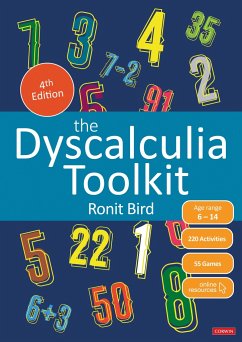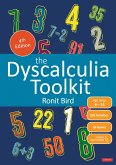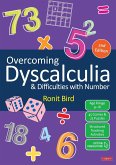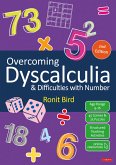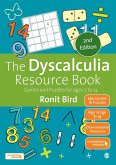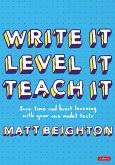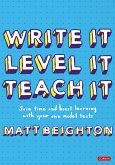- Broschiertes Buch
- Merkliste
- Auf die Merkliste
- Bewerten Bewerten
- Teilen
- Produkt teilen
- Produkterinnerung
- Produkterinnerung
Designed for all teachers, this book provides a wealth of materials and resources to support the needs of learners, aged 6 to 14 years, who have difficulty with maths and number.
Packed full with 220 activities and 55 games, the author provides you with a complete toolkit to enable you to understand dyscalculia and implement practical and innovative strategies to use in the classroom or at home.
This fourth edition is updated with new content including:
- more on dice and board games, multiplication and division;
- new downloadable and printable teaching materials (including…mehr
Andere Kunden interessierten sich auch für
![The Dyscalculia Toolkit The Dyscalculia Toolkit]() Ronit BirdThe Dyscalculia Toolkit122,99 €
Ronit BirdThe Dyscalculia Toolkit122,99 €![Overcoming Dyscalculia and Difficulties with Number Overcoming Dyscalculia and Difficulties with Number]() Ronit BirdOvercoming Dyscalculia and Difficulties with Number34,99 €
Ronit BirdOvercoming Dyscalculia and Difficulties with Number34,99 €![Overcoming Dyscalculia and Difficulties with Number Overcoming Dyscalculia and Difficulties with Number]() Ronit BirdOvercoming Dyscalculia and Difficulties with Number101,99 €
Ronit BirdOvercoming Dyscalculia and Difficulties with Number101,99 €![The Dyscalculia Resource Book The Dyscalculia Resource Book]() Ronit BirdThe Dyscalculia Resource Book32,99 €
Ronit BirdThe Dyscalculia Resource Book32,99 €![Write It Level It Teach It Write It Level It Teach It]() Matt BeightonWrite It Level It Teach It67,99 €
Matt BeightonWrite It Level It Teach It67,99 €![Teaching the Primary Curriculum Outdoors Teaching the Primary Curriculum Outdoors]() Teaching the Primary Curriculum Outdoors61,99 €
Teaching the Primary Curriculum Outdoors61,99 €![Write It Level It Teach It Write It Level It Teach It]() Matt BeightonWrite It Level It Teach It21,99 €
Matt BeightonWrite It Level It Teach It21,99 €-
-
-
Designed for all teachers, this book provides a wealth of materials and resources to support the needs of learners, aged 6 to 14 years, who have difficulty with maths and number.
Packed full with 220 activities and 55 games, the author provides you with a complete toolkit to enable you to understand dyscalculia and implement practical and innovative strategies to use in the classroom or at home.
This fourth edition is updated with new content including:
- more on dice and board games, multiplication and division;
- new downloadable and printable teaching materials (including tracking sheets, activity sheets, game boards and teaching resources);
- updated videos.
Packed full with 220 activities and 55 games, the author provides you with a complete toolkit to enable you to understand dyscalculia and implement practical and innovative strategies to use in the classroom or at home.
This fourth edition is updated with new content including:
- more on dice and board games, multiplication and division;
- new downloadable and printable teaching materials (including tracking sheets, activity sheets, game boards and teaching resources);
- updated videos.
Produktdetails
- Produktdetails
- Verlag: Corwin UK / Sage Publications
- 4. Aufl.
- Seitenzahl: 256
- Erscheinungstermin: 6. Mai 2021
- Englisch
- Abmessung: 292mm x 208mm x 16mm
- Gewicht: 677g
- ISBN-13: 9781529744323
- ISBN-10: 1529744326
- Artikelnr.: 60887465
- Verlag: Corwin UK / Sage Publications
- 4. Aufl.
- Seitenzahl: 256
- Erscheinungstermin: 6. Mai 2021
- Englisch
- Abmessung: 292mm x 208mm x 16mm
- Gewicht: 677g
- ISBN-13: 9781529744323
- ISBN-10: 1529744326
- Artikelnr.: 60887465
Ronit Bird is a teacher whose interest in pupils with specific learning difficulties began with a focus on dyslexia. She qualified as a teacher at London University and subsequently gained a further qualification as a specialist teacher of learners with SpLD. While working with dyslexic pupils in a mainstream school, Ronit started to develop strategies and teaching activities to help support the learning of pupils who were experiencing difficulties in maths. Ronit has taught in both primary and secondary settings, and has worked as a SENCO in both the independent and state sectors. As part of the Harrow Dyscalculia Project in 2006-2010, Ronit ran training courses on dyscalculia for subject leaders, teachers and teaching assistants, later working in an advisory capacity with participating schools across the Harrow LEA. Ronit currently works as a teacher and continues to create and deliver professional development courses for teachers. Over the past few years Ronit has developed a growing interest in making demonstration videos for teachers and parents.
Introduction
Section I: Early Number Work with Numbers Up to 10
Overview
What are the main problems?
Activity - Make dot patterns for the numbers 1 to 10
Activity - Focus on key component facts
Activity - Make transparent dot pattern cards for the numbers 1 to 5
Game - Make 5
Activity - Explore smaller numbers inside larger numbers
Game - Numbers Inside
Activity - Change one dot pattern into another
Activity - Change dot patterns by adding or subtracting
Activity - Use dot patterns to explore the idea of odd and even
Game - Collect 5s
Game - Key Components Guessing Game
Activity - Sort and re-sort a set of dominoes
Activity - Connect subtraction to addition
Activity - Regroup: Apply logic to find new component facts from given facts
Activities - Become familiar with Cuisenaire rods
Activity - Explore odd and even with Cuisenaire rods and with money
Game - Odd and Even Collectors
Game - Draw Your Race on a Number Line
Activities - Use Cuisenaire rods to learn all components of the numbers 1-10
Activity - Make a 'Story' of a number
Game - Race to Tell a Story
Activity - Make and read equations with Cuisenaire rods
Activity - Draw and record equations informally
Game - Key Facts Triad Game
Game - Post-It Note Subtraction
Activities - Record equations in writing
Activity - Make up word problems to match a given number fact
Game - Cover the Numbers, or Shut the Box
Game - Clear the Deck
Activity - Make a bead string, in two colours, of 10 beads
Activities - Learn complements of 10 with the bead string
Game - How Many Beads? How Many Are Hidden?
Activity - Find complements of 10 with Cuisenaire rods
Game - Complements Number Search
Game - Complements Ping-Pong
Game - Ten in a Bed
Activities - Explore and learn the doubles up to 5 plus 5
Activities - Estimate and measure using Cuisenaire rods
Activities - Focus on plus/minus 1 and plus/minus 2
Game - Who Has the Most Equations?
Game - Domino Tens
Activity - Compare the difference and equalise
Activities - Hidden quantity subtraction
Activity - Teach complementary addition
Activity - Complementary addition on a number line
Activity - Make up word problems about missing numbers
Activity - Use reasoning to find near-complements and near-doubles
Activity - Identify the best strategy for different situations
Activities - Use money for component work
SECTION 2: Basic Calculation with Numbers Above 10
Overview
What are the main problems?
How to help
Activity - Connect the numbers 10-20 with the numbers below 10
Game - Polka Dots
Game - Regroup
Activities - Focus on the 'teen' numbers
Activities - Explore the numbers between 10 and 20 with Cuisenaire rods
Activity - Learn the doubles up to 10 plus 10
Game - Double Take
Game - It All Adds Up
Activities - Locate 2-digit numbers and put them in context
Activities - Complements to 20
Activity - Complements to larger multiples of 10
Activity - Complements on a number line
Activity - Introduce bridging through 10 with Cuisenaire rods
Game - Five and What's Left
Activity - Bridge through 10 on a number line
Activity - Practise bridging and reinforce the commutativity of addition
Game - Frame an Addition
Activity - Bridge through multiples of 10 on a number line
Game - Race Along a Number Line and Bridge
Game - Race to the End of the Number Line
Activity - Complementary addition, or subtraction by adding
Game - Frame a Subtraction
Activity - Complementary addition for subtracting round numbers
Activity - Harder complementary addition on a number line
Activities - Complements to 100
Game - Keep the Change!
Activities - Practise and extend the doubles facts
Activity - Halving is the opposite of doubling
Activity - Find half of round numbers
Activity - Function machines for doubling and halving
Activity - Use reasoning to find near-complements and near-doubles
Activity - 9 is almost 10
Activity - The Basic 8 strategies
Activity - Identify which strategy works best in different situations
Game - Subtraction Equations
Activity - A flexible approach to partitioning
Activities - Explore partitioning methods for 2-digit mental additions
Activity - Teach an expanded written method for column addition
Activity - Avoid decomposition in subtraction
SECTION 3: Place Value
Overview
A note about the threefold nature of the column labelling system
What are the main problems?
How to help
Activities - Exchange units into tens
Activities - Concrete counting on place value mats
Game - Magic 10s
Activities - Make a 20-step staircase and explore the 'teen' number names
Activity - Cover 20
Game - Race to Cover 100
Game - Four Throws to Reach 100
Activities - Make and read numbers made of Cuisenaire rods or base-10 materials
Games - Dice and spinner games
Activities - Practise subtraction and decomposition with concrete materials
Game - Spot the Decomposition
Activities - Use a spike abacus
Game - Win Counters on a 100-Square
Game - Race through a 100-Square
Activities - Practise adding and subtracting 10 and 100
Game - Steer the Number
Activity - Transform a 2-digit number in two steps
Activity - Teach the threefold repeating pattern: units, tens and hundreds
Activities - Explore place value as a shorthand
Activities - Read and write multi-digit numbers
Activities - Build up large numbers, one column at a time
Activity - What is the value of ...?
Game - Two-Digit Sequences
Game - Three-Digit Sequences (Focus on Tens)
Game - Place Value Boxes
Game - Calculator Skittles
Activity - Partition numbers into tens and units in various ways
Activity - Split off the 'teen' numbers
Game - Jump 10
Activities - Locate any number on a number line
Activity - Round up or down
Game - The Six-Card Rounding Game
Game - The Rounding Challenge
Activity - Teach x 10 and divded by 10 as a shift between columns
Activity - Extend place value thinking to decimals
Activity - Connect decimal place value notation to money
Game - Rounding Races
SECTION 4: Times Tables, Multiplication and Division
Overview
What are the main problems?
How to help
Activities - Build small numbers out of equal-sized groups
Activity - Connect division to multiplication from the very beginning
Activity - Illustrate simple word problems
Activity - Use Cuisenaire rods to show that multiplication is commutative
Activities - Use Cuisenaire rods to connect multiplication and division
Activity - Diagrammatic recording of multiplication and division
Activity - Connect step-counting and repeated addition with times tables
Activity - Practise mental step-counting from given tables facts
Activities - Make times tables patterns on a 100-square
Activities - Make times tables patterns on number lines
Activities - Key fact: Double means 'multiply by 2'
Activity - Key facts: x5 is half of x10
Activity - How many 10s? So, twice as many 5s
Activity - Key facts division practice
Activity - x9 is almost x10
Game - Don't Walk if You Can Take the Bus
Activity - Find all the steps of any times table by reasoning from key facts
Activity - Practise all the steps of any times table by reasoning from key facts
Activity - Find division facts by reasoning from key facts
Game - Mouse Tables
Activity - Construct a multiplication grid
Activity - Complete a partially filled multiplication grid
Games using self-correcting cards to practise individual times tables
Game - Multiples from the 1-6 Times Tables
Activity - Harder mixed tables practice
Game - Products in a Row
Game - Factors
Activities - Change the shape of the multiplication rectangle
Game - Areas on a Grid
Activity - Use rectangle sketches to help derive new multiplication facts
Activity - Use rods to explore short division
Activity - Teach an expanded written notation for short division
Activity - Use rectangle sketches to support short division
Activity - Compare division sketches to multiplication sketches
Activity - Teach the divisibility rules
Game - Divisibility Rules
Activity - Boxes for long multiplication
Recommended Books and Resources
Appendix: Introduction to Concrete Manipulative Materials
Section I: Early Number Work with Numbers Up to 10
Overview
What are the main problems?
Activity - Make dot patterns for the numbers 1 to 10
Activity - Focus on key component facts
Activity - Make transparent dot pattern cards for the numbers 1 to 5
Game - Make 5
Activity - Explore smaller numbers inside larger numbers
Game - Numbers Inside
Activity - Change one dot pattern into another
Activity - Change dot patterns by adding or subtracting
Activity - Use dot patterns to explore the idea of odd and even
Game - Collect 5s
Game - Key Components Guessing Game
Activity - Sort and re-sort a set of dominoes
Activity - Connect subtraction to addition
Activity - Regroup: Apply logic to find new component facts from given facts
Activities - Become familiar with Cuisenaire rods
Activity - Explore odd and even with Cuisenaire rods and with money
Game - Odd and Even Collectors
Game - Draw Your Race on a Number Line
Activities - Use Cuisenaire rods to learn all components of the numbers 1-10
Activity - Make a 'Story' of a number
Game - Race to Tell a Story
Activity - Make and read equations with Cuisenaire rods
Activity - Draw and record equations informally
Game - Key Facts Triad Game
Game - Post-It Note Subtraction
Activities - Record equations in writing
Activity - Make up word problems to match a given number fact
Game - Cover the Numbers, or Shut the Box
Game - Clear the Deck
Activity - Make a bead string, in two colours, of 10 beads
Activities - Learn complements of 10 with the bead string
Game - How Many Beads? How Many Are Hidden?
Activity - Find complements of 10 with Cuisenaire rods
Game - Complements Number Search
Game - Complements Ping-Pong
Game - Ten in a Bed
Activities - Explore and learn the doubles up to 5 plus 5
Activities - Estimate and measure using Cuisenaire rods
Activities - Focus on plus/minus 1 and plus/minus 2
Game - Who Has the Most Equations?
Game - Domino Tens
Activity - Compare the difference and equalise
Activities - Hidden quantity subtraction
Activity - Teach complementary addition
Activity - Complementary addition on a number line
Activity - Make up word problems about missing numbers
Activity - Use reasoning to find near-complements and near-doubles
Activity - Identify the best strategy for different situations
Activities - Use money for component work
SECTION 2: Basic Calculation with Numbers Above 10
Overview
What are the main problems?
How to help
Activity - Connect the numbers 10-20 with the numbers below 10
Game - Polka Dots
Game - Regroup
Activities - Focus on the 'teen' numbers
Activities - Explore the numbers between 10 and 20 with Cuisenaire rods
Activity - Learn the doubles up to 10 plus 10
Game - Double Take
Game - It All Adds Up
Activities - Locate 2-digit numbers and put them in context
Activities - Complements to 20
Activity - Complements to larger multiples of 10
Activity - Complements on a number line
Activity - Introduce bridging through 10 with Cuisenaire rods
Game - Five and What's Left
Activity - Bridge through 10 on a number line
Activity - Practise bridging and reinforce the commutativity of addition
Game - Frame an Addition
Activity - Bridge through multiples of 10 on a number line
Game - Race Along a Number Line and Bridge
Game - Race to the End of the Number Line
Activity - Complementary addition, or subtraction by adding
Game - Frame a Subtraction
Activity - Complementary addition for subtracting round numbers
Activity - Harder complementary addition on a number line
Activities - Complements to 100
Game - Keep the Change!
Activities - Practise and extend the doubles facts
Activity - Halving is the opposite of doubling
Activity - Find half of round numbers
Activity - Function machines for doubling and halving
Activity - Use reasoning to find near-complements and near-doubles
Activity - 9 is almost 10
Activity - The Basic 8 strategies
Activity - Identify which strategy works best in different situations
Game - Subtraction Equations
Activity - A flexible approach to partitioning
Activities - Explore partitioning methods for 2-digit mental additions
Activity - Teach an expanded written method for column addition
Activity - Avoid decomposition in subtraction
SECTION 3: Place Value
Overview
A note about the threefold nature of the column labelling system
What are the main problems?
How to help
Activities - Exchange units into tens
Activities - Concrete counting on place value mats
Game - Magic 10s
Activities - Make a 20-step staircase and explore the 'teen' number names
Activity - Cover 20
Game - Race to Cover 100
Game - Four Throws to Reach 100
Activities - Make and read numbers made of Cuisenaire rods or base-10 materials
Games - Dice and spinner games
Activities - Practise subtraction and decomposition with concrete materials
Game - Spot the Decomposition
Activities - Use a spike abacus
Game - Win Counters on a 100-Square
Game - Race through a 100-Square
Activities - Practise adding and subtracting 10 and 100
Game - Steer the Number
Activity - Transform a 2-digit number in two steps
Activity - Teach the threefold repeating pattern: units, tens and hundreds
Activities - Explore place value as a shorthand
Activities - Read and write multi-digit numbers
Activities - Build up large numbers, one column at a time
Activity - What is the value of ...?
Game - Two-Digit Sequences
Game - Three-Digit Sequences (Focus on Tens)
Game - Place Value Boxes
Game - Calculator Skittles
Activity - Partition numbers into tens and units in various ways
Activity - Split off the 'teen' numbers
Game - Jump 10
Activities - Locate any number on a number line
Activity - Round up or down
Game - The Six-Card Rounding Game
Game - The Rounding Challenge
Activity - Teach x 10 and divded by 10 as a shift between columns
Activity - Extend place value thinking to decimals
Activity - Connect decimal place value notation to money
Game - Rounding Races
SECTION 4: Times Tables, Multiplication and Division
Overview
What are the main problems?
How to help
Activities - Build small numbers out of equal-sized groups
Activity - Connect division to multiplication from the very beginning
Activity - Illustrate simple word problems
Activity - Use Cuisenaire rods to show that multiplication is commutative
Activities - Use Cuisenaire rods to connect multiplication and division
Activity - Diagrammatic recording of multiplication and division
Activity - Connect step-counting and repeated addition with times tables
Activity - Practise mental step-counting from given tables facts
Activities - Make times tables patterns on a 100-square
Activities - Make times tables patterns on number lines
Activities - Key fact: Double means 'multiply by 2'
Activity - Key facts: x5 is half of x10
Activity - How many 10s? So, twice as many 5s
Activity - Key facts division practice
Activity - x9 is almost x10
Game - Don't Walk if You Can Take the Bus
Activity - Find all the steps of any times table by reasoning from key facts
Activity - Practise all the steps of any times table by reasoning from key facts
Activity - Find division facts by reasoning from key facts
Game - Mouse Tables
Activity - Construct a multiplication grid
Activity - Complete a partially filled multiplication grid
Games using self-correcting cards to practise individual times tables
Game - Multiples from the 1-6 Times Tables
Activity - Harder mixed tables practice
Game - Products in a Row
Game - Factors
Activities - Change the shape of the multiplication rectangle
Game - Areas on a Grid
Activity - Use rectangle sketches to help derive new multiplication facts
Activity - Use rods to explore short division
Activity - Teach an expanded written notation for short division
Activity - Use rectangle sketches to support short division
Activity - Compare division sketches to multiplication sketches
Activity - Teach the divisibility rules
Game - Divisibility Rules
Activity - Boxes for long multiplication
Recommended Books and Resources
Appendix: Introduction to Concrete Manipulative Materials
Introduction
Section I: Early Number Work with Numbers Up to 10
Overview
What are the main problems?
Activity - Make dot patterns for the numbers 1 to 10
Activity - Focus on key component facts
Activity - Make transparent dot pattern cards for the numbers 1 to 5
Game - Make 5
Activity - Explore smaller numbers inside larger numbers
Game - Numbers Inside
Activity - Change one dot pattern into another
Activity - Change dot patterns by adding or subtracting
Activity - Use dot patterns to explore the idea of odd and even
Game - Collect 5s
Game - Key Components Guessing Game
Activity - Sort and re-sort a set of dominoes
Activity - Connect subtraction to addition
Activity - Regroup: Apply logic to find new component facts from given facts
Activities - Become familiar with Cuisenaire rods
Activity - Explore odd and even with Cuisenaire rods and with money
Game - Odd and Even Collectors
Game - Draw Your Race on a Number Line
Activities - Use Cuisenaire rods to learn all components of the numbers 1-10
Activity - Make a 'Story' of a number
Game - Race to Tell a Story
Activity - Make and read equations with Cuisenaire rods
Activity - Draw and record equations informally
Game - Key Facts Triad Game
Game - Post-It Note Subtraction
Activities - Record equations in writing
Activity - Make up word problems to match a given number fact
Game - Cover the Numbers, or Shut the Box
Game - Clear the Deck
Activity - Make a bead string, in two colours, of 10 beads
Activities - Learn complements of 10 with the bead string
Game - How Many Beads? How Many Are Hidden?
Activity - Find complements of 10 with Cuisenaire rods
Game - Complements Number Search
Game - Complements Ping-Pong
Game - Ten in a Bed
Activities - Explore and learn the doubles up to 5 plus 5
Activities - Estimate and measure using Cuisenaire rods
Activities - Focus on plus/minus 1 and plus/minus 2
Game - Who Has the Most Equations?
Game - Domino Tens
Activity - Compare the difference and equalise
Activities - Hidden quantity subtraction
Activity - Teach complementary addition
Activity - Complementary addition on a number line
Activity - Make up word problems about missing numbers
Activity - Use reasoning to find near-complements and near-doubles
Activity - Identify the best strategy for different situations
Activities - Use money for component work
SECTION 2: Basic Calculation with Numbers Above 10
Overview
What are the main problems?
How to help
Activity - Connect the numbers 10-20 with the numbers below 10
Game - Polka Dots
Game - Regroup
Activities - Focus on the 'teen' numbers
Activities - Explore the numbers between 10 and 20 with Cuisenaire rods
Activity - Learn the doubles up to 10 plus 10
Game - Double Take
Game - It All Adds Up
Activities - Locate 2-digit numbers and put them in context
Activities - Complements to 20
Activity - Complements to larger multiples of 10
Activity - Complements on a number line
Activity - Introduce bridging through 10 with Cuisenaire rods
Game - Five and What's Left
Activity - Bridge through 10 on a number line
Activity - Practise bridging and reinforce the commutativity of addition
Game - Frame an Addition
Activity - Bridge through multiples of 10 on a number line
Game - Race Along a Number Line and Bridge
Game - Race to the End of the Number Line
Activity - Complementary addition, or subtraction by adding
Game - Frame a Subtraction
Activity - Complementary addition for subtracting round numbers
Activity - Harder complementary addition on a number line
Activities - Complements to 100
Game - Keep the Change!
Activities - Practise and extend the doubles facts
Activity - Halving is the opposite of doubling
Activity - Find half of round numbers
Activity - Function machines for doubling and halving
Activity - Use reasoning to find near-complements and near-doubles
Activity - 9 is almost 10
Activity - The Basic 8 strategies
Activity - Identify which strategy works best in different situations
Game - Subtraction Equations
Activity - A flexible approach to partitioning
Activities - Explore partitioning methods for 2-digit mental additions
Activity - Teach an expanded written method for column addition
Activity - Avoid decomposition in subtraction
SECTION 3: Place Value
Overview
A note about the threefold nature of the column labelling system
What are the main problems?
How to help
Activities - Exchange units into tens
Activities - Concrete counting on place value mats
Game - Magic 10s
Activities - Make a 20-step staircase and explore the 'teen' number names
Activity - Cover 20
Game - Race to Cover 100
Game - Four Throws to Reach 100
Activities - Make and read numbers made of Cuisenaire rods or base-10 materials
Games - Dice and spinner games
Activities - Practise subtraction and decomposition with concrete materials
Game - Spot the Decomposition
Activities - Use a spike abacus
Game - Win Counters on a 100-Square
Game - Race through a 100-Square
Activities - Practise adding and subtracting 10 and 100
Game - Steer the Number
Activity - Transform a 2-digit number in two steps
Activity - Teach the threefold repeating pattern: units, tens and hundreds
Activities - Explore place value as a shorthand
Activities - Read and write multi-digit numbers
Activities - Build up large numbers, one column at a time
Activity - What is the value of ...?
Game - Two-Digit Sequences
Game - Three-Digit Sequences (Focus on Tens)
Game - Place Value Boxes
Game - Calculator Skittles
Activity - Partition numbers into tens and units in various ways
Activity - Split off the 'teen' numbers
Game - Jump 10
Activities - Locate any number on a number line
Activity - Round up or down
Game - The Six-Card Rounding Game
Game - The Rounding Challenge
Activity - Teach x 10 and divded by 10 as a shift between columns
Activity - Extend place value thinking to decimals
Activity - Connect decimal place value notation to money
Game - Rounding Races
SECTION 4: Times Tables, Multiplication and Division
Overview
What are the main problems?
How to help
Activities - Build small numbers out of equal-sized groups
Activity - Connect division to multiplication from the very beginning
Activity - Illustrate simple word problems
Activity - Use Cuisenaire rods to show that multiplication is commutative
Activities - Use Cuisenaire rods to connect multiplication and division
Activity - Diagrammatic recording of multiplication and division
Activity - Connect step-counting and repeated addition with times tables
Activity - Practise mental step-counting from given tables facts
Activities - Make times tables patterns on a 100-square
Activities - Make times tables patterns on number lines
Activities - Key fact: Double means 'multiply by 2'
Activity - Key facts: x5 is half of x10
Activity - How many 10s? So, twice as many 5s
Activity - Key facts division practice
Activity - x9 is almost x10
Game - Don't Walk if You Can Take the Bus
Activity - Find all the steps of any times table by reasoning from key facts
Activity - Practise all the steps of any times table by reasoning from key facts
Activity - Find division facts by reasoning from key facts
Game - Mouse Tables
Activity - Construct a multiplication grid
Activity - Complete a partially filled multiplication grid
Games using self-correcting cards to practise individual times tables
Game - Multiples from the 1-6 Times Tables
Activity - Harder mixed tables practice
Game - Products in a Row
Game - Factors
Activities - Change the shape of the multiplication rectangle
Game - Areas on a Grid
Activity - Use rectangle sketches to help derive new multiplication facts
Activity - Use rods to explore short division
Activity - Teach an expanded written notation for short division
Activity - Use rectangle sketches to support short division
Activity - Compare division sketches to multiplication sketches
Activity - Teach the divisibility rules
Game - Divisibility Rules
Activity - Boxes for long multiplication
Recommended Books and Resources
Appendix: Introduction to Concrete Manipulative Materials
Section I: Early Number Work with Numbers Up to 10
Overview
What are the main problems?
Activity - Make dot patterns for the numbers 1 to 10
Activity - Focus on key component facts
Activity - Make transparent dot pattern cards for the numbers 1 to 5
Game - Make 5
Activity - Explore smaller numbers inside larger numbers
Game - Numbers Inside
Activity - Change one dot pattern into another
Activity - Change dot patterns by adding or subtracting
Activity - Use dot patterns to explore the idea of odd and even
Game - Collect 5s
Game - Key Components Guessing Game
Activity - Sort and re-sort a set of dominoes
Activity - Connect subtraction to addition
Activity - Regroup: Apply logic to find new component facts from given facts
Activities - Become familiar with Cuisenaire rods
Activity - Explore odd and even with Cuisenaire rods and with money
Game - Odd and Even Collectors
Game - Draw Your Race on a Number Line
Activities - Use Cuisenaire rods to learn all components of the numbers 1-10
Activity - Make a 'Story' of a number
Game - Race to Tell a Story
Activity - Make and read equations with Cuisenaire rods
Activity - Draw and record equations informally
Game - Key Facts Triad Game
Game - Post-It Note Subtraction
Activities - Record equations in writing
Activity - Make up word problems to match a given number fact
Game - Cover the Numbers, or Shut the Box
Game - Clear the Deck
Activity - Make a bead string, in two colours, of 10 beads
Activities - Learn complements of 10 with the bead string
Game - How Many Beads? How Many Are Hidden?
Activity - Find complements of 10 with Cuisenaire rods
Game - Complements Number Search
Game - Complements Ping-Pong
Game - Ten in a Bed
Activities - Explore and learn the doubles up to 5 plus 5
Activities - Estimate and measure using Cuisenaire rods
Activities - Focus on plus/minus 1 and plus/minus 2
Game - Who Has the Most Equations?
Game - Domino Tens
Activity - Compare the difference and equalise
Activities - Hidden quantity subtraction
Activity - Teach complementary addition
Activity - Complementary addition on a number line
Activity - Make up word problems about missing numbers
Activity - Use reasoning to find near-complements and near-doubles
Activity - Identify the best strategy for different situations
Activities - Use money for component work
SECTION 2: Basic Calculation with Numbers Above 10
Overview
What are the main problems?
How to help
Activity - Connect the numbers 10-20 with the numbers below 10
Game - Polka Dots
Game - Regroup
Activities - Focus on the 'teen' numbers
Activities - Explore the numbers between 10 and 20 with Cuisenaire rods
Activity - Learn the doubles up to 10 plus 10
Game - Double Take
Game - It All Adds Up
Activities - Locate 2-digit numbers and put them in context
Activities - Complements to 20
Activity - Complements to larger multiples of 10
Activity - Complements on a number line
Activity - Introduce bridging through 10 with Cuisenaire rods
Game - Five and What's Left
Activity - Bridge through 10 on a number line
Activity - Practise bridging and reinforce the commutativity of addition
Game - Frame an Addition
Activity - Bridge through multiples of 10 on a number line
Game - Race Along a Number Line and Bridge
Game - Race to the End of the Number Line
Activity - Complementary addition, or subtraction by adding
Game - Frame a Subtraction
Activity - Complementary addition for subtracting round numbers
Activity - Harder complementary addition on a number line
Activities - Complements to 100
Game - Keep the Change!
Activities - Practise and extend the doubles facts
Activity - Halving is the opposite of doubling
Activity - Find half of round numbers
Activity - Function machines for doubling and halving
Activity - Use reasoning to find near-complements and near-doubles
Activity - 9 is almost 10
Activity - The Basic 8 strategies
Activity - Identify which strategy works best in different situations
Game - Subtraction Equations
Activity - A flexible approach to partitioning
Activities - Explore partitioning methods for 2-digit mental additions
Activity - Teach an expanded written method for column addition
Activity - Avoid decomposition in subtraction
SECTION 3: Place Value
Overview
A note about the threefold nature of the column labelling system
What are the main problems?
How to help
Activities - Exchange units into tens
Activities - Concrete counting on place value mats
Game - Magic 10s
Activities - Make a 20-step staircase and explore the 'teen' number names
Activity - Cover 20
Game - Race to Cover 100
Game - Four Throws to Reach 100
Activities - Make and read numbers made of Cuisenaire rods or base-10 materials
Games - Dice and spinner games
Activities - Practise subtraction and decomposition with concrete materials
Game - Spot the Decomposition
Activities - Use a spike abacus
Game - Win Counters on a 100-Square
Game - Race through a 100-Square
Activities - Practise adding and subtracting 10 and 100
Game - Steer the Number
Activity - Transform a 2-digit number in two steps
Activity - Teach the threefold repeating pattern: units, tens and hundreds
Activities - Explore place value as a shorthand
Activities - Read and write multi-digit numbers
Activities - Build up large numbers, one column at a time
Activity - What is the value of ...?
Game - Two-Digit Sequences
Game - Three-Digit Sequences (Focus on Tens)
Game - Place Value Boxes
Game - Calculator Skittles
Activity - Partition numbers into tens and units in various ways
Activity - Split off the 'teen' numbers
Game - Jump 10
Activities - Locate any number on a number line
Activity - Round up or down
Game - The Six-Card Rounding Game
Game - The Rounding Challenge
Activity - Teach x 10 and divded by 10 as a shift between columns
Activity - Extend place value thinking to decimals
Activity - Connect decimal place value notation to money
Game - Rounding Races
SECTION 4: Times Tables, Multiplication and Division
Overview
What are the main problems?
How to help
Activities - Build small numbers out of equal-sized groups
Activity - Connect division to multiplication from the very beginning
Activity - Illustrate simple word problems
Activity - Use Cuisenaire rods to show that multiplication is commutative
Activities - Use Cuisenaire rods to connect multiplication and division
Activity - Diagrammatic recording of multiplication and division
Activity - Connect step-counting and repeated addition with times tables
Activity - Practise mental step-counting from given tables facts
Activities - Make times tables patterns on a 100-square
Activities - Make times tables patterns on number lines
Activities - Key fact: Double means 'multiply by 2'
Activity - Key facts: x5 is half of x10
Activity - How many 10s? So, twice as many 5s
Activity - Key facts division practice
Activity - x9 is almost x10
Game - Don't Walk if You Can Take the Bus
Activity - Find all the steps of any times table by reasoning from key facts
Activity - Practise all the steps of any times table by reasoning from key facts
Activity - Find division facts by reasoning from key facts
Game - Mouse Tables
Activity - Construct a multiplication grid
Activity - Complete a partially filled multiplication grid
Games using self-correcting cards to practise individual times tables
Game - Multiples from the 1-6 Times Tables
Activity - Harder mixed tables practice
Game - Products in a Row
Game - Factors
Activities - Change the shape of the multiplication rectangle
Game - Areas on a Grid
Activity - Use rectangle sketches to help derive new multiplication facts
Activity - Use rods to explore short division
Activity - Teach an expanded written notation for short division
Activity - Use rectangle sketches to support short division
Activity - Compare division sketches to multiplication sketches
Activity - Teach the divisibility rules
Game - Divisibility Rules
Activity - Boxes for long multiplication
Recommended Books and Resources
Appendix: Introduction to Concrete Manipulative Materials
